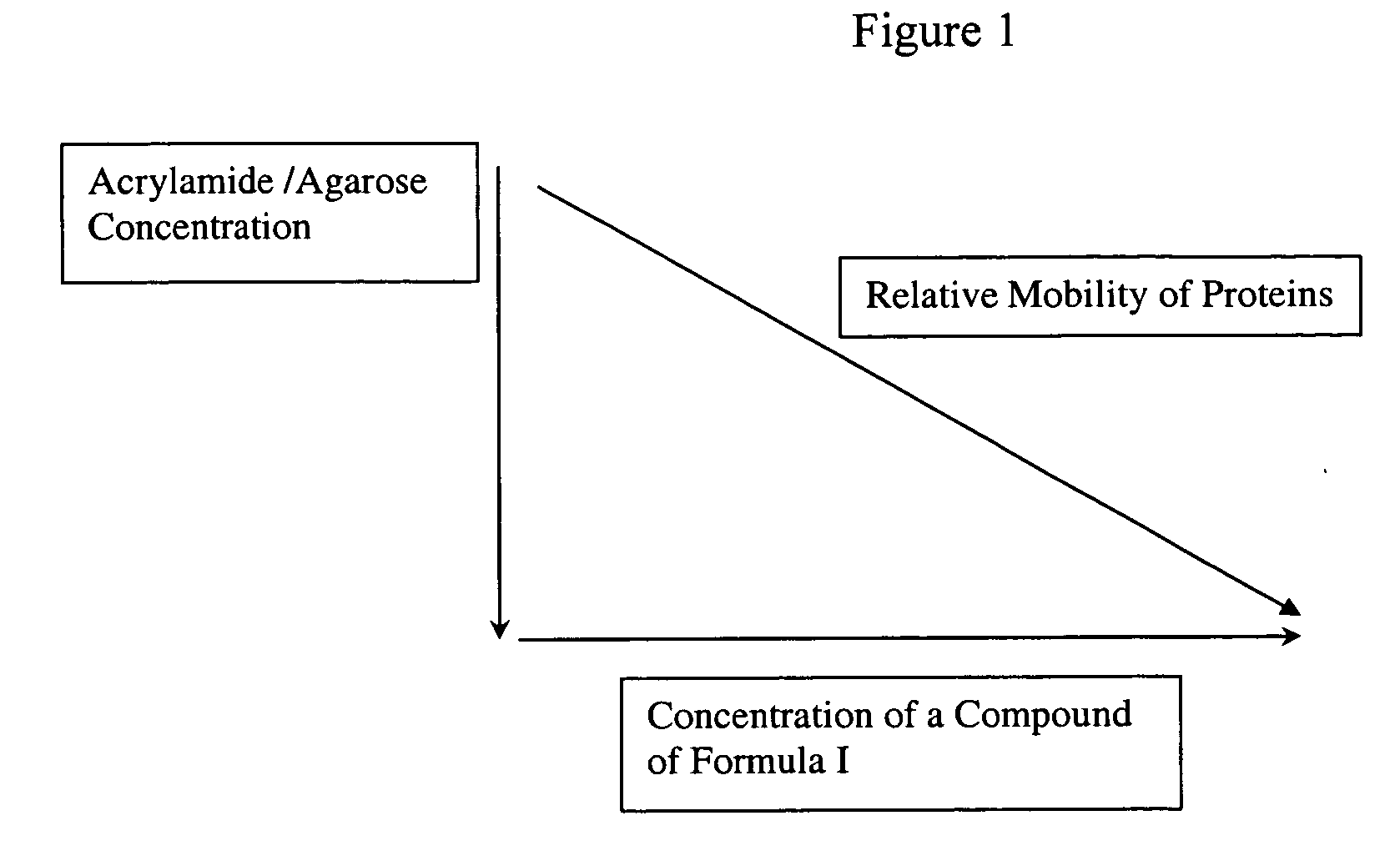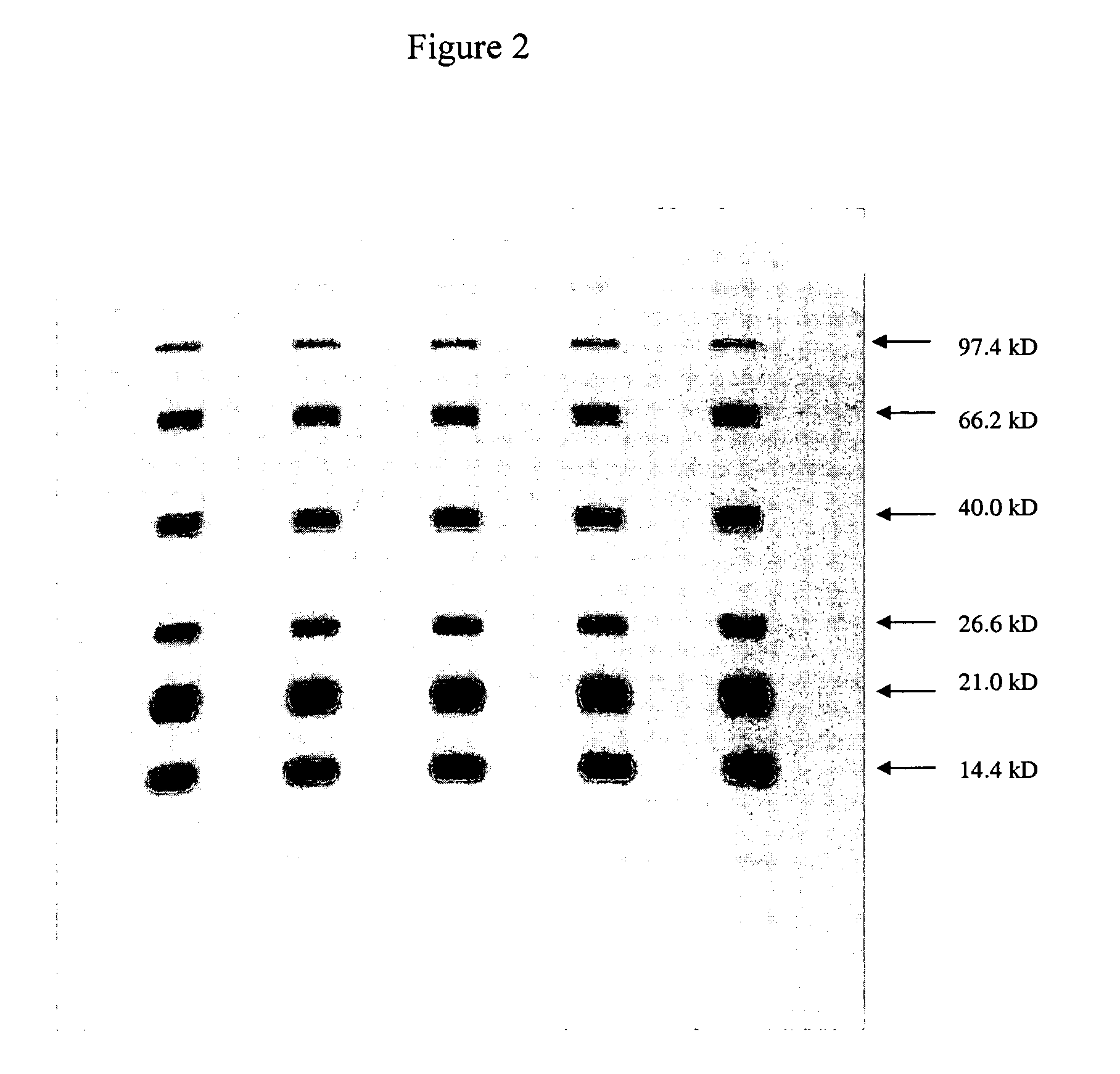Electrophoresis gels and buffers and methods of performing electrophoresis
a technology of electrophoresis gel and electrophoresis method, which is applied in the direction of liquid/fluent solid measurement, fluid pressure measurement, peptide, etc., can solve the problems of increasing the pore size, reducing the separation rate, so as to achieve high throughput protein separation, easy preparation, and improved separation rate
- Summary
- Abstract
- Description
- Claims
- Application Information
AI Technical Summary
Benefits of technology
Problems solved by technology
Method used
Image
Examples
example 1
Preparation of Gel and Electrophoresis Method
[0068] A pre-mixed solution was prepared with a 7.5% polyacrylamide gel, 333 mM MOPS, 0.667% SDS, 0.2% EDTA and Tris base (sufficient to bring the pH to 7.0). The running buffer was made up of 50 mM MOPS, Tris (sufficient to bring the pH to 7.7) 0.1% SDS and 0.03% EDTA. 10 mL of the pre-mixed solution was mixed with 6 ul of TEMED and 60 ul of freshly made 10% APS, and the solution was mixed and poured immediately. A comb was inserted and the gel was allowed to polymerize for at least 20 minutes. The running buffer was applied to the anode and cathode chambers and test samples were added to the buffer and heated to 95-100 degrees C. for 5 minutes. 10-15 ul of the sample was applied to each well. A 200 volt potential was applied for about one hour until the dye reached the bottom of the gel. The gel was stained for proteins using 0.1% coomassie in 50% methanol / 10% acetic acid solution for 15 minutes followed by 12.5% methanol / 2.5% acetic a...
example 2
SDS-PAGE Gel Comprising MOPS
[0069] A 10% polyacrylamide gel was prepared with 333 mM MOPS and 0.6% SDS (pH 7.7) in the separating gel buffer, as described in Example 1. Electrophoresis was performed on a protein sample with molecular weights ranging from 14.4 kD to 97.4 kD, as described in Example 1. The running buffer used was also a 333 mM MOPS and 0.6% SDS (pH 7.7) buffer.
[0070] The results are shown in FIG. 2. The figure shows the fine resolution of all proteins in general. In addition, some of the low molecular weight proteins, especially in the range of 14.4 kD to 26.6 kD, migrated slower and with superior resolution compared to that of standard Laemmli gels that did not contain MOPS.
[0071] This result is rather unexpected since the resolution of proteins on acrylamide gels is generally considered to be solely dependent on polyacrylamide concentration and not on the nature of the buffer component.
example 3
Pre-Mixed Gel Solution Comprising MOPS
[0072] A pre-mixed gel solution containing 10% acrylamide, 333 mM MOPS and 0.6% SDS was prepared, and a gel was prepared using this pre-mixed solution. The characteristics of the gel comprising MOPS were compared to that of standard Laemmli gel (12% acrylamide) system by using the gels to perform electrophoresis on identical samples. The composition of the samples is shown below in Table 1.
TABLE 1ProteinMW (Daltons)Myosin212000Beta-Galactosidase116000Phosphorylase-B97400Albumin66200Ovalbumin40000Aldolase38000Carbonic Anhydrase31000Triose Phosphate Isomerase26600Trypsin Inhibitor21000Myoglobin17000Lysozyme14400Alpha-Lactalbumin14200Aprotinin6500Insulin B-Oxidized3500
The results are shown in FIG. 3 below. The figure indicates that the gel comprising MOPS provided superior protein resolution compared to the standard Laemmli gel.
PUM
| Property | Measurement | Unit |
|---|---|---|
| pH | aaaaa | aaaaa |
| pH | aaaaa | aaaaa |
| pH | aaaaa | aaaaa |
Abstract
Description
Claims
Application Information
 Login to View More
Login to View More - R&D
- Intellectual Property
- Life Sciences
- Materials
- Tech Scout
- Unparalleled Data Quality
- Higher Quality Content
- 60% Fewer Hallucinations
Browse by: Latest US Patents, China's latest patents, Technical Efficacy Thesaurus, Application Domain, Technology Topic, Popular Technical Reports.
© 2025 PatSnap. All rights reserved.Legal|Privacy policy|Modern Slavery Act Transparency Statement|Sitemap|About US| Contact US: help@patsnap.com



